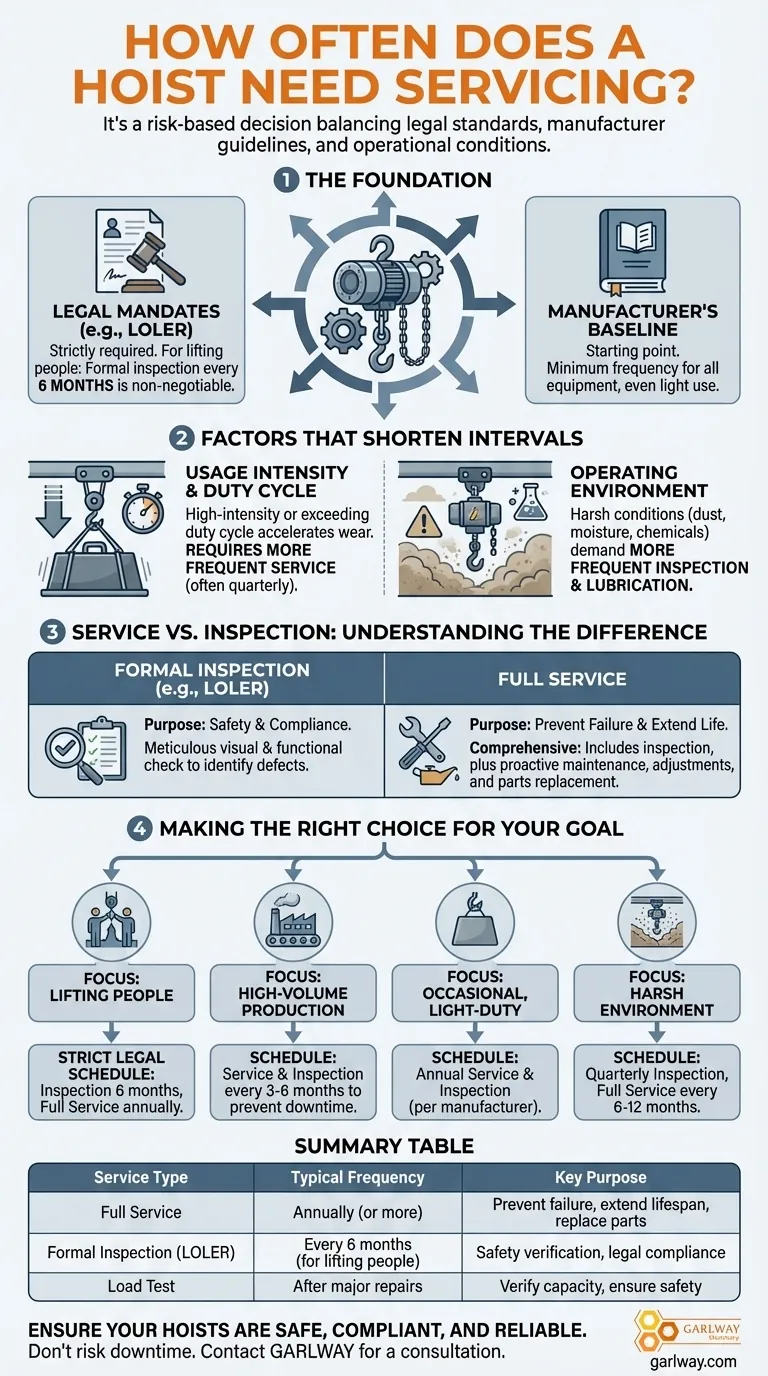At a minimum, a hoist requires a thorough service and inspection annually, but this frequency can increase to every three to six months based on legal requirements, usage intensity, and the operating environment. For equipment that lifts people, such as patient hoists, a formal inspection is legally mandated every six months, with a full service required once per year.
The correct service frequency for a hoist is not a single, universal number. It is a risk-based decision that balances manufacturer recommendations with the specific legal standards, duty cycle, and environmental conditions of your operation.

The Foundation: Legal vs. Manufacturer Guidance
Every maintenance plan begins by understanding the two primary sources of guidance. These set the absolute minimum requirements for keeping your equipment safe and compliant.
Legal & Regulatory Mandates
For certain applications, the law dictates the inspection schedule. The most common standard is the Lifting Operations and Lifting Equipment Regulations (LOLER).
Under LOLER, equipment used for lifting people must be formally inspected by a competent person at least every six months. This is a non-negotiable legal obligation.
Manufacturer's Baseline
Every hoist is sold with a manual that outlines a recommended service schedule. This is your starting point and the minimum frequency you should consider for any equipment, even with light use.
Key Factors That Shorten Your Service Interval
The manufacturer's recommendation assumes normal operating conditions. You must shorten the time between services if your hoist faces more demanding circumstances.
Usage Intensity and Duty Cycle
The duty cycle defines how long a hoist can run before it needs a rest period to cool down. Consistently operating a hoist for long periods or frequently lifting loads near its maximum rated capacity constitutes high-intensity use.
Exceeding the recommended duty cycle significantly accelerates wear on the motor, brakes, and load chain or wire rope, demanding more frequent servicing—often quarterly.
The Operating Environment
A hoist's surroundings have a major impact on its components. A unit in a clean, temperature-controlled workshop will have a different wear pattern than one in a foundry or chemical plant.
Harsh environments with dust, moisture, or corrosive chemicals require more frequent inspection and lubrication to prevent premature failure.
Understanding the Trade-offs: Service vs. Inspection
It's critical to distinguish between a routine service and a formal inspection, as they serve different purposes. Both are essential for a comprehensive maintenance strategy.
The Purpose of a Formal Inspection
A formal inspection is a meticulous visual and functional check performed by a certified, competent person to identify any potential defects that could compromise safety.
Its primary goal is safety and compliance. This is what a LOLER test accomplishes.
The Scope of a Full Service
A full service is more comprehensive. It includes the elements of an inspection but also involves proactive maintenance like lubrication, adjustments, and the replacement of high-wear parts.
Its primary goal is preventing failure and extending the equipment's operational life.
When a Load Test is Necessary
In some cases, such as after a major repair or as part of a thorough inspection, a full load test may be recommended. This test verifies that the hoist can still safely handle its maximum rated capacity.
Making the Right Choice for Your Goal
Use these scenarios to determine the correct service frequency for your specific situation.
- If your primary focus is lifting people: You must follow a strict legal schedule of a formal inspection every six months and a full service annually.
- If your primary focus is high-volume production: Schedule service and inspections every 3 to 6 months to account for the high duty cycle and prevent unplanned downtime.
- If your primary focus is occasional, light-duty lifting: An annual service and inspection, in line with the manufacturer's recommendation, is generally appropriate.
- If your primary focus is operating in a harsh environment: Implement a quarterly inspection schedule to check for corrosion or contamination, with a full service every 6 to 12 months.
Ultimately, a proactive maintenance schedule based on your specific use case is the only way to ensure safety, compliance, and long-term reliability.
Summary Table:
| Service Type | Typical Frequency | Key Purpose |
|---|---|---|
| Full Service | Annually (or more) | Prevent failure, extend lifespan, replace parts |
| Formal Inspection (LOLER) | Every 6 months (for lifting people) | Safety verification, legal compliance |
| Load Test | After major repairs | Verify capacity, ensure safety |
Ensure your hoists are safe, compliant, and reliable.
Don't risk downtime or safety violations. GARLWAY specializes in providing durable construction machinery, including winches and hoists, trusted by construction companies and contractors globally. Our expertise ensures your equipment meets the highest standards.
Contact GARLWAY today for a consultation on your hoist maintenance needs and discover the right service schedule for your operation.
Visual Guide

Related Products
- Electric Hoist Winch Boat Anchor Windlass for Marine Applications
- Commercial Construction Mixer Machine for Soil Cement Mixing Concrete
- Small Electric Winch 120V and 240V for Compact Applications
- Portable Concrete Mixer Machine Equipment for Mixing Concrete
- Warn Winch Windlass Boat Trailer Winch
People Also Ask
- What are the pros and cons of electrical winches? Make the Right Choice for Your Project
- How should the hoist winch be debugged after installation? A 3-Phase Guide to Ensure Safety & Reliability
- How do electric hoists help prevent workplace injuries? Engineer a Safer, More Efficient Workspace
- What are the key steps for installing a hoist winch? Ensure Safety & Reliability for Your Project
- What are the advantages of an electrically operated trailer winch? Enhance Safety & Control for Your Trailer







